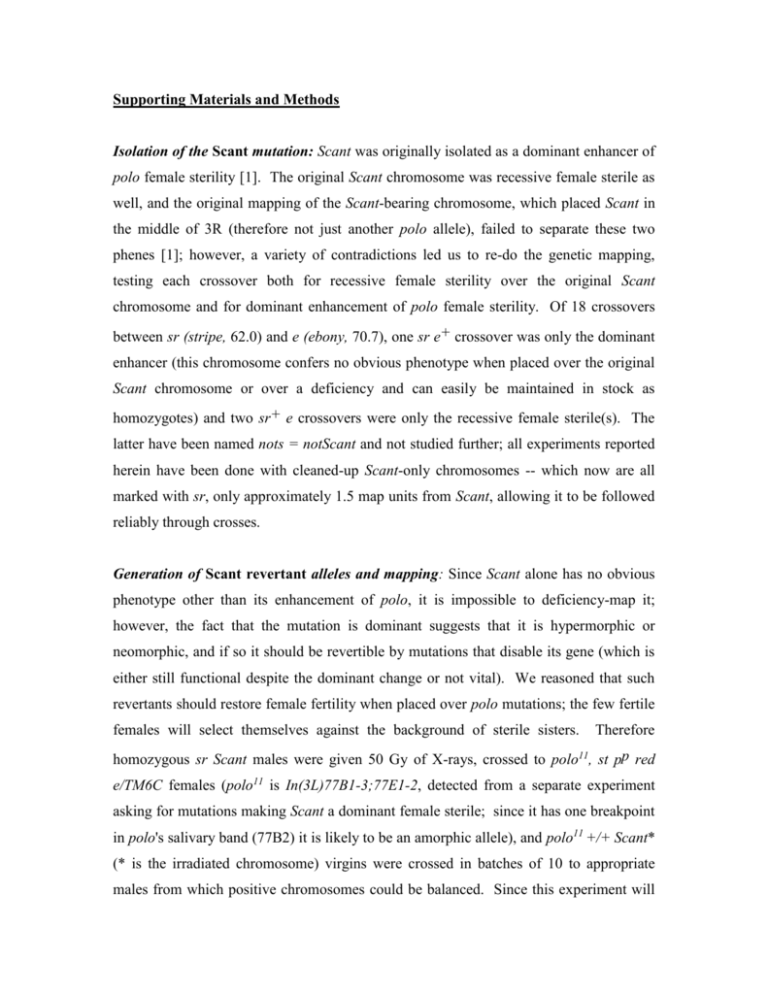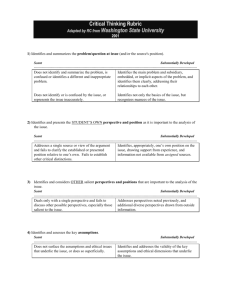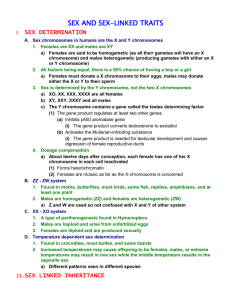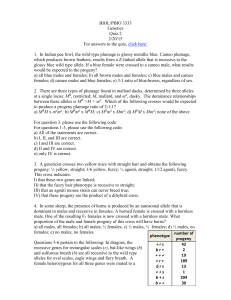Supporting Materials and Methods
advertisement

Supporting Materials and Methods Isolation of the Scant mutation: Scant was originally isolated as a dominant enhancer of polo female sterility [1]. The original Scant chromosome was recessive female sterile as well, and the original mapping of the Scant-bearing chromosome, which placed Scant in the middle of 3R (therefore not just another polo allele), failed to separate these two phenes [1]; however, a variety of contradictions led us to re-do the genetic mapping, testing each crossover both for recessive female sterility over the original Scant chromosome and for dominant enhancement of polo female sterility. Of 18 crossovers between sr (stripe, 62.0) and e (ebony, 70.7), one sr e+ crossover was only the dominant enhancer (this chromosome confers no obvious phenotype when placed over the original Scant chromosome or over a deficiency and can easily be maintained in stock as homozygotes) and two sr+ e crossovers were only the recessive female sterile(s). The latter have been named nots = notScant and not studied further; all experiments reported herein have been done with cleaned-up Scant-only chromosomes -- which now are all marked with sr, only approximately 1.5 map units from Scant, allowing it to be followed reliably through crosses. Generation of Scant revertant alleles and mapping: Since Scant alone has no obvious phenotype other than its enhancement of polo, it is impossible to deficiency-map it; however, the fact that the mutation is dominant suggests that it is hypermorphic or neomorphic, and if so it should be revertible by mutations that disable its gene (which is either still functional despite the dominant change or not vital). We reasoned that such revertants should restore female fertility when placed over polo mutations; the few fertile females will select themselves against the background of sterile sisters. Therefore homozygous sr Scant males were given 50 Gy of X-rays, crossed to polo11, st pp red e/TM6C females (polo11 is In(3L)77B1-3;77E1-2, detected from a separate experiment asking for mutations making Scant a dominant female sterile; since it has one breakpoint in polo's salivary band (77B2) it is likely to be an amorphic allele), and polo11 +/+ Scant* (* is the irradiated chromosome) virgins were crossed in batches of 10 to appropriate males from which positive chromosomes could be balanced. Since this experiment will detect not only hits that reduce the function of Scant's gene but also third-site interactors, and also because the tested females are not balanced for the third so crossing-over should be uninhibited, multiple stocks, each from an individual e+ progeny, were established from each positive culture and each was retested for suppression of polo sterility. Five solid suppressing events (Sr = Scant revertant) were recovered out of the 5492 chromosomes tested, though the background was unexpectedly high; about one in 8 vials (= 80 females) had a few larvae that failed to produce adults and about one vial in 50 produced a few adults that failed on retest. This leakage is temperature-sensitive; it is increased by culture at 18oC relative to the normal 22oC but this effect is too subtle to allow determination of the temperature-sensitive stage. Two of the positive Scant revertants, Sr3 and Sr6, appeared likely to be the desired hits in Scant's gene. They retested as positives, still carried sr, and had gained recessive subvital mutations which were allelic and which deficiency-mapped just to the right of sr, where the dominant mapped. Sr3 has no cytological defect and its lesion is hypomorphic; homozygotes (on good food in uncrowded cultures) have eclosion delay but eventually the expected 1/3 eclose. These adults do have a range of phenotypes, such as slightly to very reduced rough eyes and incomplete abdominal cuticle, indicative of difficulties in cell-cycle progression. Sr3/Df progeny have reduced viability as well as more severe eye and wing phenotypes. Sr6 has an (unrelated?) cytological defect; it is a tandem duplication for 90EF;92DE. This should mean two copies of Scant, which is in the middle of the region duplicated; however, Sr6 does behave as a simple reduction of function and only one PCR product is recovered for any part of the gwl gene. Although its chromosome is homozygous lethal, this is from some second event since it gives escapers over deficiency (with the same phenes as Sr3); moreover, Sr6/Sr3 behaves more like Sr3/Sr3 than like Sr3/Df, indicating that Sr6 is also a hypomorphic allele, though somewhat more defective than Sr3. The frequency of hits in Scant's gene, 2/5492, is well within the range of decrease-of-function hits in other recessive genes (st, p, e, ca: 0.9-4.6 x 10-4) that were monitored to gauge the effectiveness of the mutagenesis. Two of the positives are duplications for polo+ -- Dp(3;3)polo-Sr4,76D5-8;77E3-5 into 83A and Dp(3;3)polo-Sr8,76D1;77E1-3. Though unexpected (X-rays hit mature sperm, only one copy of the genome is present -- but I [ATCC] had left the treated males with their females long enough so that pre-meiotic events could have been recovered), these events both nail the point of the polo-Scant interaction (see Results) and provide material for the next experiment. The final positive is a deficiency in 3L, which identifies a real third-site interactor since independent deficiencies of its region also suppress the sterility of polo-Scant females. This first run worked so well it clearly should be carried forward, now with polo11 and Scant in cis for efficiency (Figure S1); polo11, st pp red e/Dp(3;3)polo-Sr4 or Dp(3;3)polo-Sr8, sr Scant females were crossed to ruPrica males and scarlet striped crossovers were selected -- as, and kept as, males, since the desired polo11 Scant doublemutant chromosome is female sterile. Two different lines (one each from Sr4 and Sr8) were kept and each was used for X-ray mutagenesis; they behaved identically. Males were again treated with 50 Gy but now they were crossed to TM6C females and polo11 Scant/TM6C daughters were tested for fertility again in batches of 10 (and the X-rayed fathers were removed after 6 days). This run did give positives but most were large deficiencies that removed the Scant mutant gene outright; the balancer-heterozygous females also gave much lower levels of leakiness than the first run, suggesting that the deleterious effects of balancer heterozygosity were tipping what should have been partlyfertile positives into cultures too infertile for recovery of the positive chromosome. Late in the run polo11 Scant*/+ + sisters were also tested; leakiness went back up but no positives were recovered from the few such females. This second run produced 4 cytologically visible deficiencies (all removing 91C5,6, Scant's band), one T(2;3) [56F10-17;91C3-D5] and two invisible deficiencies (detected as deficiencies by PCR) out of 14,789 females tested as well as three cytologicallynormal positives, Sr17, Sr19, and Sr18. Sr17 and Sr19 are very similar and indeed could have come from the same father; they have indistinguishable changes in the vicinity of the Scant gene. Neither gives a PCR product for the kb 5' of gwl (between 71k and 72k, Figure 1); this is unlikely to be a large deletion because attempts to PCR across this region from either side also fail, although the adjacent regions themselves PCR up fine. We suspect the insertion of a natural transposon 5' of gwl, down-regulating it. Both are + only semi-fertile in the presence of a polo allele but fully fertile in a polo background, and neither displays any obvious recessive defect except that fertility of polo11 Sr17 or Sr19/Sr3 females is even more reduced. Sr18 is fully viable and phenotypically normal in the absence of polo but females are completely sterile (lay lots of eggs that do not develop); this same sterility occurs in Sr18/Sr3 or Sr18/Sr6 females, so Sr18 is a hit that disrupts Scant's maternal effect without affecting the somatic effect of its gene. The various mappings of the recessive Scant hits narrowed its recessive subvital to Df(3R)Exel6181, 91C5;91D5, bases 14 554 953-14 770 980; the next step was to mobilise P inserts in the region to induce imprecise excisions, crossing all progeny either to Df(3R)Exel6181 and testing lethals for a recessive Scant phenotype (both positive and negative results would have been informative) or to Sr3/Bal directly. Several spaced insertions were tested; the one that proved fully successful was gwl EP515 , inserted 217 bp 5' of gwl and 12 bp 5' of CG7718. Although the original insertion chromosome carries a nearby, unrelated recessive lethal (removed by crossing-over in the positives before further study), the insertion itself over deficiencies for its region is fully viable, phenotypically normal, and fully fertile in both sexes. All of the P-chromosome-carrying progeny of seven P-insert/Dr delta 2-3 males were tested, sorted by father so that premeiotic clusters could be identified; seven useful positives were recovered (see below for sequence information). Three independent events (gwl2, gwl3a, and gwl6a) fail to complement Sr3; three independent events (CG77181, CG77186b, and CG77187) complement Sr3 but fail to complement each other; and one event (gwl3b) fails to complement both. gwl2, gwl3a, gwl6a, and gwl3b have white eyes, having lost the inserted mini-white; the rest retain the lemon eye color of the original insertion line. All of the events that fail to complement Sr3 not only give (mutant) escapers at the reduced frequency diagnostic of large deficiencies, they also give the occasional escaper as homozygotes or over larger deficiencies, and the lethality is mostly late pupal lethal. Since the P-hop experiment implies that either gwl or CG7718 is the Scant gene, primers were designed for PCR at 1 kb intervals across both genes. All three of the events that uncovered Sr3 extend distal into gwl (= one or more kbs failed to PCR up); all three that complemented Sr3 extend proximal into or past CG7718; and gwl3b removed sequences both ways. The recessive phenotypes identified by Sr3 etc. are therefore likely to be defects in gwl. Of course, Scant itself was sequenced first; there are 30 differences within the transcribed sequence between Scant and the genome sequence, 25 in introns or silent codons, 5 changing an amino acid when compared with the FlyBase sequence -K97M, S391G, T395S, P432Q and E846D. Although what stock presently in the Glover-lab collection might have been Scant's progenitor is lost in the mists of time, the original stocks of several of the other mutations recovered from its mutagenesis are still present; their gwl+ genes were PCRed and sequenced and they do have all the silent and amino acid changes of Scant except one: K97M (base 14,573,098 is changed from an A to a T; this changes amino acid 97 from Lys to Met). This suggests that the K97M substitution in gwl is the dominant Scant mutation that results in the sterility of heterozygous polo mutant females. That this is the Scant mutation has been confirmed by artificial induction and transformation (see below). Sequencing the gwl gene in Sr3 identified a 27 base pair deletion, removing 9 codons for the residues 156-164 in the N-terminal part of the kinase fold (Figure 5). Sr6 has an ochre codon in place of lysine 678. Both mutations retain the same five codon differences (compared with the FlyBase gwl sequence) as Scant, including K97M. Rescue of viability and fertility tests: To ask whether Gwl-long or Gwl-short could rescue the viability of gwlSr3/gwlSr6 mutants, Act5C-Gal4 UASp-gwl-(long or short)/CyO; gwlSr6/MKRS or +/CyO; gwlSr6/MKRS (control) males were crossed to gwlSr3/TM6C females. CyO/CyO and MKRS/TM6C are lethal, and gwlSr3/gwlSr6 is largely inviable on the food used in this experiment (without gwl transgenic expression) so the few escapers were excluded from the total progeny number used in the calculations. This leaves 5 (out of 8) classes of progeny. If rescue is complete, we expect the number of Act5C-Gal4, UASp-gwl-(long or short)/+; gwlSr3/gwlSr6 progeny to be 1/4 of the sum of the remaining 4 progeny classes. Therefore, the number of Act5C-Gal4, UASp-gwl-(long or short)/+;gwSr3/gwlSr6 progeny flies was divided by 1/4 of the total number of the remaining 4 classes, giving the percentage of rescue. In the control crosses, UASp-gwl(long or short) was replaced by a + chromosome. To ask whether Gwl-long rescues the fertility of gwlSr18/Df mutants, Mat -Tub-Gal UASp-gwl-long; Df(3R)Exel6181/MKRS males were crossed to gwlSr18/TM6B females. Three-day-old Mat -Tub-Gal4 UASp-gwl-long/+; gwlSr18/Df(3R)Exel6181 females (and their siblings) were tested for fertility individually with 3 Oregon R males. Females were allowed to lay eggs for 3 days, then transferred to fresh food for one day, three times (6 days egg laying total). The total number of progeny was scored for 3 to 4 females of each genotype and averaged. A similar experiment was done to ask whether Gwl-short rescues the fertility of gwlSr18/Df mutants. w1118; Mat -Tub-Gal UASp-gwl-short/(If or CyO); gwlSr18/TM6B males were crossed to w1118; If/CyO; Df(3R)Exel6181/TM6B females. Three-day-old w1118; Mat -Tub-Gal4 UASp-gwl-short/If; gwlSr18/Df females (and their siblings) were tested for fertility individually with 3 Oregon R males. Females were allowed to lay eggs for 3 days, then transferred to fresh food for one day, two times, and transferred again on fresh food for two days (7 days egg laying total). The total number of progeny was scored for 5 to 9 females of each genotype and averaged.







